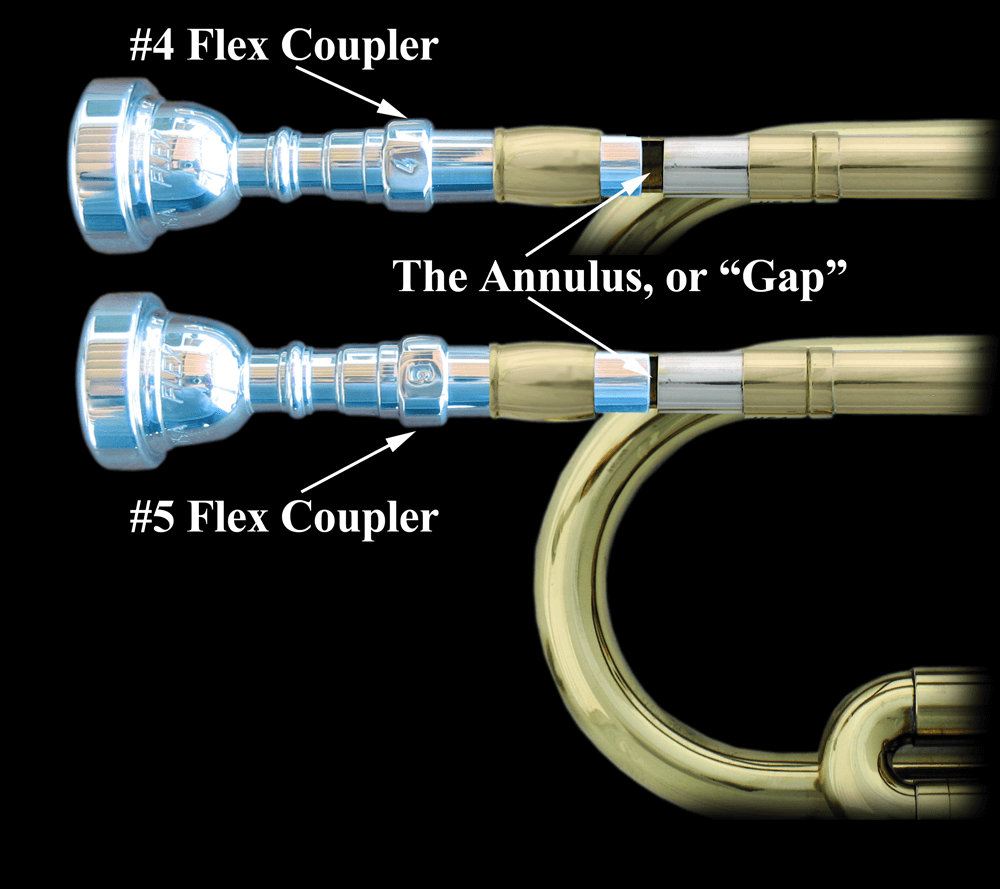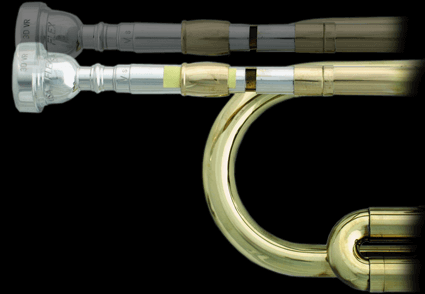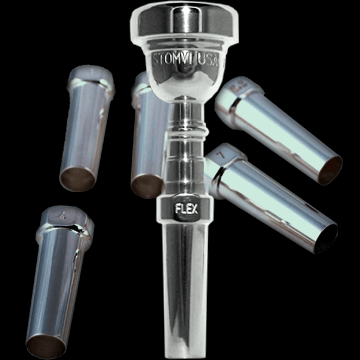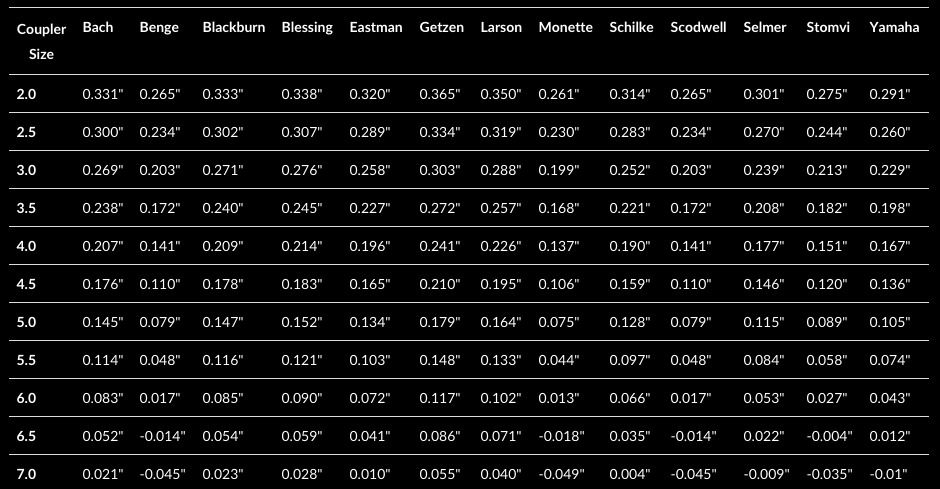Learn about the mouthpiece/trumpet annulus (gap)
- The Gap is important. It is the best way to optimize the performance of your set-up.
- The optimum gap is specific to the individual player, their mouthpiece, and their trumpet.
- The optimum gap for each situation must be discovered through experimentation.
The information below will explain the what, how, and why of the gap based on our studies, experimentation, and experience.
ADJUSTING THE ANNULUS (GAP) IS PRIMARILY AN ACOUSTIC PHENOMENON.
IT HELPS DETERMINE THE LOCATION (RELATIVE PITCH) OF THE SLOTS.
Definition of The Annulus, or Gap

Receiver cut-away showing the “gap”
The “gap” affects the pitch center, or slot of every note on the trumpet. It does this by affecting the intonation of every note.
When the gap is not correct, you must compensate using your chops and air in an effort to make all the notes be in tune and sound as even in possible. This means you are working harder than you need to to play the instrument.
Signs of an incorrect gap:
- Some notes are sharp and some notes are flat.
- The upper register speaks well, while the low register speaks badly.
- The low register speaks well, while the upper register is difficult.
- All or some registers feel stuffy.
- All or some registers feel too open.
THE GAP IS THE MOST IMPORTANT DIMENSION THAT CAN EASILY BE ADJUSTED TO:
- Make the upper register as easy as possible.
- Improve your endurance.
- Give you a full, resonant sound full of harmonics, or tonal colors.
- Improve the low register.
- Ensure the best intonation possible with your mouthpiece, your trumpet, and the way you play.
- Give you more sound for less work.
The video below explains what the gap between the mouthpiece and leadpipe is.
The goal in adjusting the gap is to get the highest percentage of notes in tune with themselves.
The Function of The Gap
When the gap is adjusted correctly, it allows you to use your air
in the most efficient manner possible.
Determining the Correct Gap
Using a Mouthpiece that is Converted for Couplers:
Start with the smallest number Coupler you have and play an F major scale from F in the staff to the octave above (just on top of the staff).
When you get to the top F listen and see if you have to:
- Push up to be in tune.
- Come down to be in tune.
- Do nothing to be in tune (in other words, the pitch, or slot, is right where you want it to be).
Then try the next numbered Coupler you have and do the same thing. After you experiment a bit, you’ll start to hear and feel the gap adjustment.
The goal is to find the gap that gives you the best intonation.
Then use the one you find best in your routine. Don’t be afraid to change Couplers as you become more experienced with the gap effect.
When you get to the top F listen and see if you have to:
- Push up to be in tune.
- Come down to be in tune.
- Do nothing to be in tune (in other words, the pitch, or slot, is right where you want it to be).
Then add a small piece of paper on the side of the shank as shown in the picture and play the scale again. If it improves you know you can benefit from a different gap.
If it gets worse or stays the same you know you are either:
- At optimum Gap
- Or you need to decrease the gap which can be done easily by having your mouthpiece converted for Flex Couplers.
The correct gap for each mouthpiece/trumpet system and player cannot be calculated.
It must be discovered through experimentation.
Gap Calculation?
Because each player pushes their lips into the mouthpiece by a different amount, this alone affects the relative intonation of the mouthpiece/trumpet system. The video to the right shows this in graphical terms.
The video below explains why gap calculations don’t work.
Annulus (gap) Frequently Asked Questions
Flex Mouthpiece with Couplers for Gap Adjustment
What is the Annulus, or Gap?
Why is the gap important?
What does the gap do?
How do I know if I have the right (or wrong) gap?
- Stuffiness in any or all registers
- Too open in any or all registers
- Bad pitch in any or all registers
Odds are high that adjusting the gap will improve things.
Is it possible to calculate the gap?
Can I expect to use the same gap with different trumpets?
I bought a Flex Mouthpiece with three Couplers: How do I know which one is best for me?
- Push Up To be in tune.
- Come down to be in tune.
- Do nothing to be in tune (in other words, the pitch, or slot, is right where you want it to be).
Then try the next numbered Coupler you have and do the same thing. After you experiment a bit, you’ll start to hear and feel the gap adjustment.
The goal is to find the gap that gives you the best intonation.
Then use the one you find best in your routine. Don’t be afraid to change Couplers as you become more experienced with the gap effect.
Can I expect to use the same gap with different mouthpieces?
How can I adjust the gap?
What is better; a smaller or larger gap?
My friend and I use the same mouthpiece and trumpet. Should we use the same gap?
Does a mouthpiece converted for Flex couplers play as well as a solid shank version?
Do the cornet, flugelhorn, and piccolo have a gap?
Does the gap affect the airflow?
When the gap is not correct acoustically, it will “feel” as though you have too much or too little back pressure, depending on a number of other factors.
Does Stomvi make quarter size Flex Couplers?
No, for the following reasons:
- Remember that the gap affects the relative intonation of all the notes.
- The intonation change caused by a quarter size is, on average, only 2 musical cents.
- The best human ears can hear about 5 musical cents.
—Therefore a quarter size gap change
is not discernible by human ears.—
In addition:
- The penetration change of a quarter size is only .015″
- It is easy to change the gap by virtually a quarter size by using excess pressure when you insert the mouthpiece into the trumpet.
—Therefore a quarter size gap change is impractical
from a mechanical standpoint.—
Furthermore:
Keep in mind that the gap is affecting the alignment of the pitches, or frequencies, of the notes. Another factor affecting this is lip penetration. How far you push your lips further into the cup of a mouthpiece affects the resonance frequency of the mouthpiece. The amount of lip penetration can vary the pitch by as much, if not more, than the pitch change caused by a quarter size gap change. Therefore you can easily end up chasing something that you’ll never catch.
—The bottom line is a half size gap change (.032″)
is more than enough to “dial things in” for your
mouthpiece, trumpet, and the way you play.
Any gap change finer than that is
impractical and therefore unnecessary.—
When your gap is optimized, you are getting the most sound for the least amount of effort.
Think of it as though Mother Nature is giving you “free gas!”
Average gap per manufacturer
Gathered through empirical measurement. Your gap may vary depending on age and model. For reference use only. All measurements in thousandths of an inch (.001).




